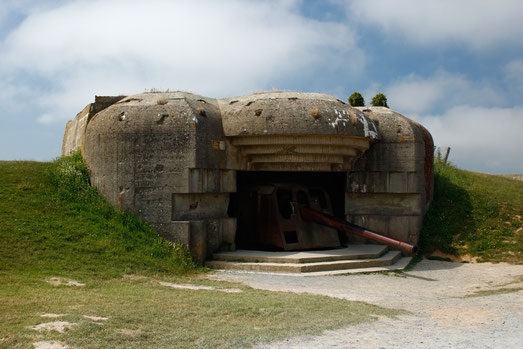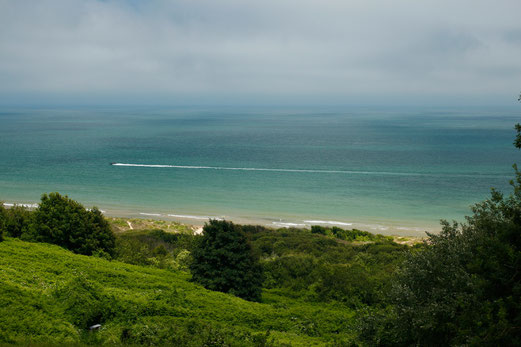Ten thousand dead Men and a castle in the sea.
July 20, 2018

The turquoise water glistens in the hot midday sun. Down at the beach I spot red and pink parasols. Nearly 9,500 white crosses upstairs. 9,500 dead American soldiers from the battle around D-Day in Normandy in 1944. First I think the tombs only symbolize fallen fighters. But when I turn around, I see a name with the date of birth and death on almost every brightly shining stone. Some of them are decorated with fresh flowers. The names are engraved to the west. "They look home," a guide explains. I'm barely able to listen to his voice. The shimmering sea, the peacefully rolling waves and at the same time the there is this weird silence. Cut by the screaming of the seagulls. I touch the green grass with my fingers and later the fine sand on Utah Beach. I want to grasp it - the incredible thing that has happened here. And yet it keeps running away.
Ruins of the German gun Battery at Gold Beach

We're driving from Saint-Paul-du-Vernay up to the coast. There we actually meet the only host who speaks perfect English. He's a teacher. The village has only about 500
inhabitants and we could not be further away from civilization than in the small house behind the stone church.
First we head for Gold Beach. These names of the beaches in Normandy were the cover names of Operation Overlord, which led to the liberation of
France during Second World War and ultimately to Hitler's downfall. The French kept the names over the years.
Here we find the German Gun Battery of Longues-sur-Mer. Between the massive concrete ruins there are some rusty gun barrels
sticking out, which are many times thicker than my leg. The sun is burning, crickets are chirping and colourful flowers are dancing in the wind. My hand glides along the broken guns. Like it was
a surreal painting by Dali. Some bunkers and facilities can even be entered. I'm standing behind one of the bomb pipes by looking out through a gap to the blue sea. It's damp and
cool in the vault. Could I have stood here and fired at complete strangers? I have to get out. The idea is too crazy.
A Carpet of Crosses and a beautiful View

We continue to Omaha Beach. There lies one of the most famous military cemeteries of Normandy: the American tomb of Colleville-sur-Mer. I have seen two gravyards and memorials that have deeply impressed and moved me yet: the Holocaust Memorial in Berlin and the Arlington Cemetery near Washington DC. But this time something is different. I just can't come up with it yet. 9,387 people are lying here. Each cross shines brightly in the sun, some have yellow and purple flowers around them. And the lines don't stop. They just don't stop. All those people who parachuted off the coast in the middle of the night with the help of ships and airplanes. Many of them who lost their lives. No, that sounds too harmless, because strangely enough I suddenly feel what really has happened here. People were shot, shredded, drowned or bled to death in the sand. People who wanted to end the horrors of World War II with a mission that was so incredibly crazy, daring and successful. D-Day in Normandy. The following fights lasted for several weeks. It wasn't just one day, as it often sounds.

Would I have jumped out of an airplane at night with a little canvas on my back, expecting to be murdered instantly on the ground?
Suddenly I know what's strange out here: the turquoise sea, the small motorboat, the laughter of the children on the beach. Everything's so fucking normal. But nothing here will ever be
normal again. Not even in 150 years. As I later stand at Utah Beach, I'm collecting sand because I have already done so on many beaches and have a small collection of
glasses at home. It sounds completely crazy, but at that moment I was wondering if I would find red sand. Of course I don't. And yet I cannot get rid of the feeling that the sea
can never wash away what has happened here.
Since there are many museums and memorials along Normandy's landing beaches, you should definitely plan on more than one day. We visited the Utah Beach Landing Museum, which shows an
impressive film from D-Day on June 6, 1944, as well as an incredible amount of finds and a large bomber plane in a hangar. As much as I love to visit historical
sites, they always get under my skin. Only now I did really understand what happened in Normandy. How terrible but also how important it has been for the life we lead
today.
The cathedral in the sea or 15 kilometers low tide

A few days later we arrive in Pontorson. The tiny village is close to Mont-Saint-Michel. Our host does not speak English and we
do not speak French. But instead of stupid strawberry crêpes our host gave me her mobile phone into which she had
spoken to give us some advice. The digital translator did the rest. We are positively surprised and together we are pleased about today's possibilities of technology.
That same evening it's high tide around 10 pm. Mont-Saint-Michel sometimes lies in the middle of the sea and sometimes not at all. The tides here are the
strongest in Europe and can make the sea move back up to 10 miles (!). Hallelujah!
At the right time for sunset we are at the cathedral on the mountain. The shuttle bus takes us over a long bridge to the gates of the strange city, where there are actually
several restaurants, hotels and even a cemetery. Oh, and 33 inhabitants (2015).
Mont-Saint-Michel - a church built from different centuries

We wait in the rippling wind for the tide to come in. And it's coming in with a power. Waves collapse, small sand dams collapse and within a very short time the endless, empty
mud flats have become a waving sea. While I smiled at the warning signs before, now it makes me feel completely different. It's like someone turned on all the cocks on a bathtub.
I try out my new ND filter on the camera, which creates a perfectly smooth water surface. Slowly the first orange lights light up on the island.
The next day we visit the cathedral on the top of the stone island. It is huge and consists of different parts. The oldest are from the year 708. At this point a
warm greeting to my American friends, who always think 1855 is "old". Over the centuries more and more buildings were added, which is why you can observe the most
different architectural styles. And a bunch of seagulls that are keen on our picnic.
The entrance fee to the cathedral is 10 Euro (July 2018) and although the mountain is very crowded in summer, we hardly had to queue. The flow of visitors inside the building was
also good. But I recommend a visit to Mont-Saint-Michel out of season - and always a fine look at the tide calendar.


